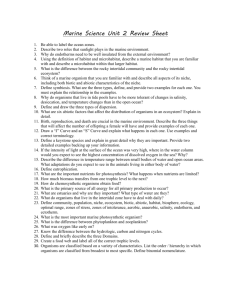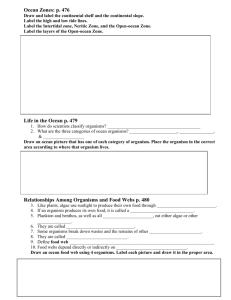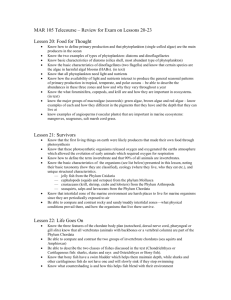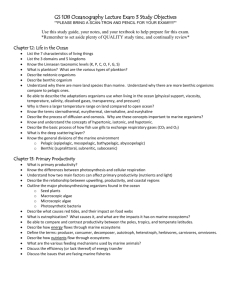Study questions Marine Bio
advertisement
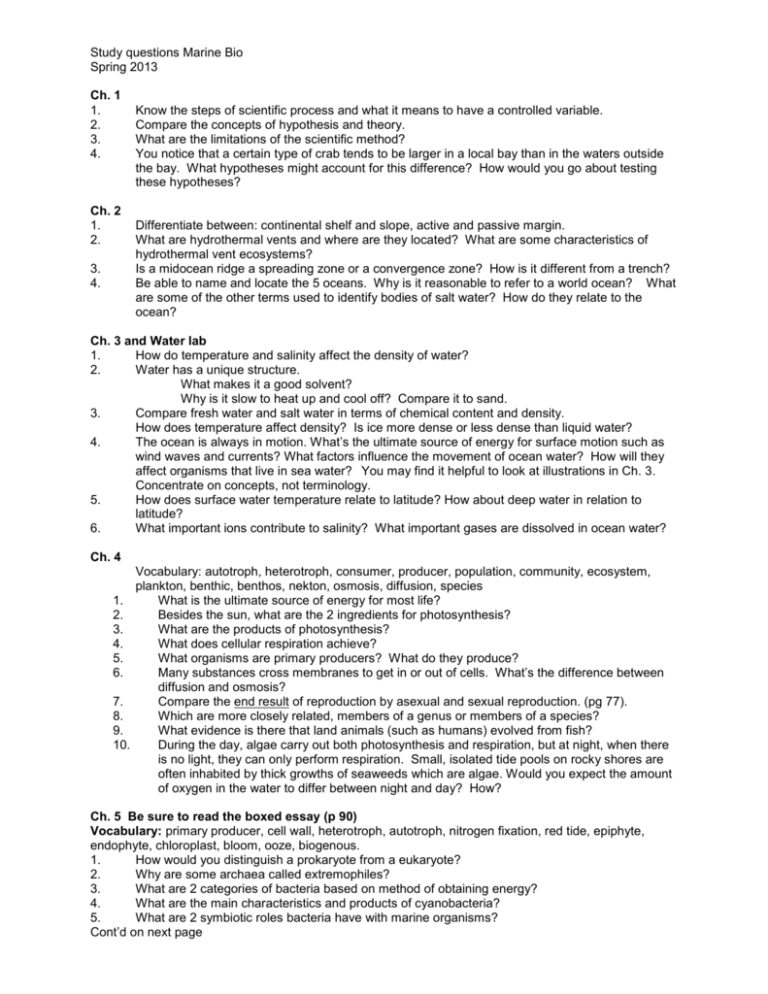
Study questions Marine Bio Spring 2013 Ch. 1 1. 2. 3. 4. Ch. 2 1. 2. 3. 4. Know the steps of scientific process and what it means to have a controlled variable. Compare the concepts of hypothesis and theory. What are the limitations of the scientific method? You notice that a certain type of crab tends to be larger in a local bay than in the waters outside the bay. What hypotheses might account for this difference? How would you go about testing these hypotheses? Differentiate between: continental shelf and slope, active and passive margin. What are hydrothermal vents and where are they located? What are some characteristics of hydrothermal vent ecosystems? Is a midocean ridge a spreading zone or a convergence zone? How is it different from a trench? Be able to name and locate the 5 oceans. Why is it reasonable to refer to a world ocean? What are some of the other terms used to identify bodies of salt water? How do they relate to the ocean? Ch. 3 and Water lab 1. How do temperature and salinity affect the density of water? 2. Water has a unique structure. What makes it a good solvent? Why is it slow to heat up and cool off? Compare it to sand. 3. Compare fresh water and salt water in terms of chemical content and density. How does temperature affect density? Is ice more dense or less dense than liquid water? 4. The ocean is always in motion. What’s the ultimate source of energy for surface motion such as wind waves and currents? What factors influence the movement of ocean water? How will they affect organisms that live in sea water? You may find it helpful to look at illustrations in Ch. 3. Concentrate on concepts, not terminology. 5. How does surface water temperature relate to latitude? How about deep water in relation to latitude? 6. What important ions contribute to salinity? What important gases are dissolved in ocean water? Ch. 4 1. 2. 3. 4. 5. 6. 7. 8. 9. 10. Vocabulary: autotroph, heterotroph, consumer, producer, population, community, ecosystem, plankton, benthic, benthos, nekton, osmosis, diffusion, species What is the ultimate source of energy for most life? Besides the sun, what are the 2 ingredients for photosynthesis? What are the products of photosynthesis? What does cellular respiration achieve? What organisms are primary producers? What do they produce? Many substances cross membranes to get in or out of cells. What’s the difference between diffusion and osmosis? Compare the end result of reproduction by asexual and sexual reproduction. (pg 77). Which are more closely related, members of a genus or members of a species? What evidence is there that land animals (such as humans) evolved from fish? During the day, algae carry out both photosynthesis and respiration, but at night, when there is no light, they can only perform respiration. Small, isolated tide pools on rocky shores are often inhabited by thick growths of seaweeds which are algae. Would you expect the amount of oxygen in the water to differ between night and day? How? Ch. 5 Be sure to read the boxed essay (p 90) Vocabulary: primary producer, cell wall, heterotroph, autotroph, nitrogen fixation, red tide, epiphyte, endophyte, chloroplast, bloom, ooze, biogenous. 1. How would you distinguish a prokaryote from a eukaryote? 2. Why are some archaea called extremophiles? 3. What are 2 categories of bacteria based on method of obtaining energy? 4. What are the main characteristics and products of cyanobacteria? 5. What are 2 symbiotic roles bacteria have with marine organisms? Cont’d on next page 6. 7. 8. 9. 10. 11. 12. Why is nitrogen fixation important to other organisms? What are some examples of protists that are producers? Differentiate diatoms from dinoflagellates. Many planktonic microorganisms have projections of some sort from their cells. What is a probable advantage of these structures? What is the role of zooxanthellae? How do protozoans differ from “plant like” protista? What is an important role of marine fungi? Ch. 6 Vocabulary: asexual and sexual, spores and gametes, sporophytes and gametophytes 1. What structural characteristics of algae (green, brown, and red) separate them from microbes and flowering plants? 2. What are the differences between the 3 phyla of multicellular algae? 3. Draw a kelp. Label holdfast, stipe, pneumatocyst, blade, and thallus 4. What is meant by alternation of generations? 5. What are 3 chemicals produced by algae that are widely used commercially? 6. Overgrazing of kelp by sea urchins led to a decline in several other animal species associated with kelp forests. Why would a decrease in amount of kelp affect animals that do not feed on kelp? 7. What are the main types and characteristics of flowering plants in marine environments? Ch. 7 We will concentrate on these groups: Sponges (Porifera), Cnidaria, Annelids, Molluscs, Arthropods, Echinoderms, Chordates. Know some common names of examples of each phylum. Sponges. 1. What type of symmetry is most common? 2.How do they feed? 3. How do they reproduce? 4.What types of relationships do they have with other animals? Cnidaria 1. What does the phylum name refer to? 2. How do they feed? 3. What type of symmetry? Why is radial symmetry advantageous to a sessile organism? What is the typical body organization for organisms with bilateral symmetry? Worms 1. How do sessile worms feed as compared with mobile worms? 2. What important ecological contribution do burrowing organisms make to the environment? Mollusks 1. What is the basic body plan? 2. The radula is an important structure for feeding. What are some of the adaptations found in different types of mollusks? 3. What adaptations allow squid to be successful predators? 4. Why do bivalves that burrow in soft sediments need siphons? 5. On a field trip to the ocean you discover a gastropod that you have never seen before. You want to know whether this animal is an herbivore or a carnivore. How cold you determine with a fair amount of certainty which type of feeder this animal is? Arthropods 1.Why are arthropods such a successful group of animals? 2. What type of growth pattern is the norm? 3. What are 4 commercially important crustaceans? Echinoderms 1. What are the common characteristics of this phylum in terms of locomotion? 2. Compare feeding habits of seastars, urchins, and sand dollars. Chordates What are 4 structures found in all chordates? Ch. 8 1. What are the most common characteristics of vertebrates? 2. Distinguish characteristics of the 3 classes of fishes. 3. Fish have fins with names based on body location. Know fin names. 4. Relate feeding habits to body shape. 5. How do bony fish and cartilaginous fish differ in their method of dealing with osmoregulation? 6. What is the purpose of lateral line, swim bladder, countercurrent in gas exchange, olfactory sacs. 7. Contrast oviparous, ovoviviparous and viviparous reproductive systems. 8. Contrast life cycles of salmon with eels. 9. What functions are served by territoriality, schooling, and migration? Ch. 9 Vocabulary: poikilotherm, ectotherm, homeotherm, endotherm, salt gland 1. What are the most common characteristics of sea turtles? 2. What are the basic characteristics of birds? 3. How are penguins adapted to swimming and cold temperatures? MAMMALS – mainly whales 1. How do we know that cetaceans are mammals? 2. What distinguishes whales from seals, sea otters and manatees? 3. How do the feeding methods of baleen whales differ from toothed whales? 4. What is being done to conserve cetaceans? 5. What are the adaptations that marine mammals have that allow them to make long, deep dives? 6. What role does echolocation have for marine mammals? 7. How do marine mammals communicate with each other? 8. What is the basic migration pattern for marine mammals? 9. What is the significance of delayed implantation? 10. How do mating and birthing patterns differ for fishes and marine mammals? Ch. 10 1. Besides temperature and salinity, what are physical factors that affect where organisms live? 2. What types of factors might slow down population growth? What factors may allow 2 species which use many of the same resources to live in the same habitat? 3. Distinguish niche from habitat; 4. Differentiate: competition, predator/prey relationships, and parasitism. 5. Distinguish mutualism, commensalism, and parasitism. 6. How do autotrophs get energy (2 methods)? 7. Describe the relationship between the producers, consumers and decomposers in the ocean. Distinguish heterotroph from autotroph. What are 3 categories of heterotrophs and their trophic levels? Give an example of a food chain. How does it differ from a food web? 8. What essentials for living are recycled? What happens to energy? 9. More terms: pelagic, phytoplankton, zooplankton. 10. What are the boundaries of the intertidal zone? Organisms below that zone are in what zone? 11. Why do scientists consider biodiversity to be important? Ch. 11 1. 2. 3. 4. What combination of factors produces spring tides? What causes vertical zonation on rocky coastlines? In general what are differences between upper intertidal, middle intertidal, and lower intertidal zones? What are the stresses of the intertidal (littoral) zone? How do animals cope with those stresses? What are some of the adaptations and structures that enable animals to live in the intertidal environment?(for example, ways to deal with desiccation, ways to deal with waves, different feeding mechanisms, locomotion, body covering, need for oxygen, temperature,etc.) Have examples of animals and how they cope. Cont’d on next page 5. 6. 7. 8. 9. What producers are on the rocks? How have they adapted to survive there? What environmental challenges are encountered by organisms that live in a tidepool? Why do organisms that live in tidepools have to be more tolerant of changes in salinity than organisms that live in the open sea? Discuss the ecological relationships between mussels, barnacles, seastars, and the alga known as rockweed on an intertidal coast. What is a keystone species? What are the stresses of living in mud, in sand? What organisms are successful and what are their adaptations for success? There are marked differences in the type of organisms found at 4 different locations at the same tidal height along a rocky shore. What might account for this? Offer at least 3 possible explanations. Consider both physical and biological factors. Ch. 12 1. Organisms in estuaries must deal with salinity. Explain the difference between euryhaline and stenohaline organisms; between osmoconformers and osmoregulators. Pay attention to Fig. 12.5 and12.6 2. Distinguish between populations, communities, and ecosystems in the marine world --- with examples. Include primary producers, detritus, birds, anadromous and catadromous fish, and infauna as well as the invertebrates that are on rocks, sand and mud. 3. Why is it important to nonestuarine animals such as migratory ducks and geese, that some estuaries remain relatively undisturbed by human activities? 4. Salt marshes play an important role as nurseries for many commercially important fishes and shellfish. What characteristics of salt marshes make them such ideal nurseries? Ch. 18 Vocabulary: anthropogenic, ocean acidification, eutrophication, anoxic, hypoxic, biological magnification


